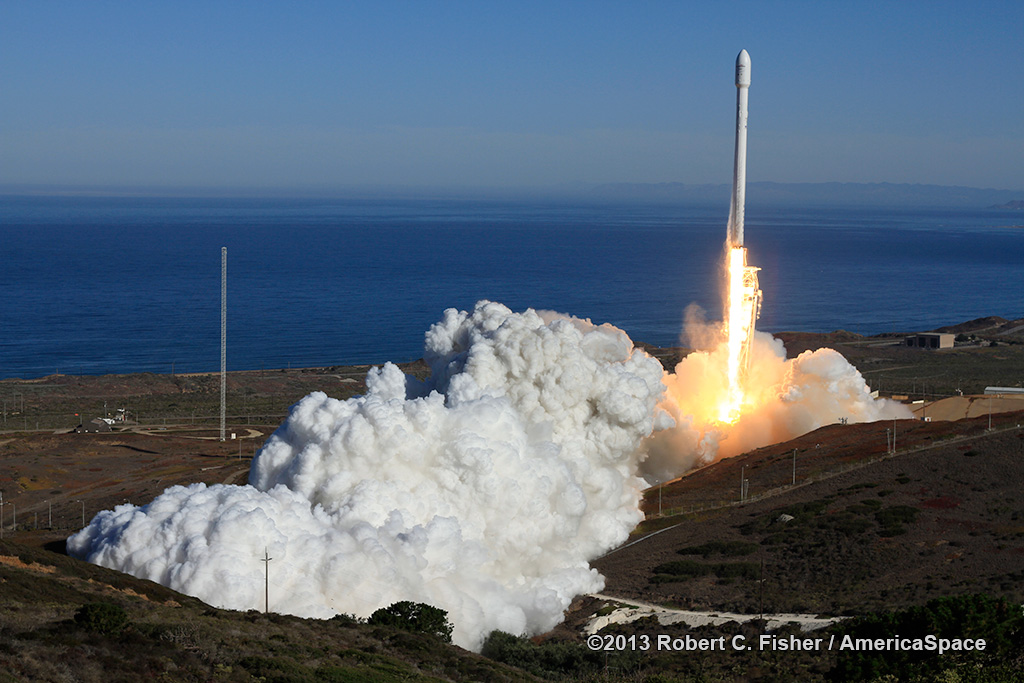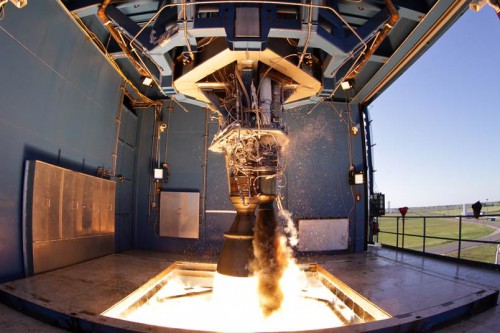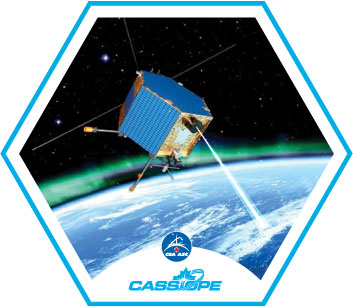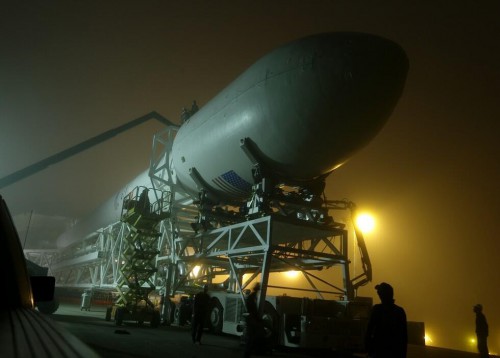
For most of us, Sunday is generally recognized as a day of rest, relaxation, and recharging of the batteries for the week ahead. Not so Sunday, 29 September 2013. With Orbital Sciences Corp. and NASA having triumphantly berthed the first Cygnus cargo ship at the International Space Station earlier this morning, and the return to flight of Russia’s Proton-M scheduled for tonight, SpaceX has staged the maiden voyage of its Falcon 9 v1.1 rocket. Liftoff of the new rocket, which benefits from uprated Merlin 1D engines, took place from Space Launch Complex (SLC)-4 East at Vandenberg Air Force Base, Calif., at 9 a.m. PDT (12 p.m. EDT). It was SpaceX’s first Falcon 9 launch from the West Coast and its first commercial flight carrying a satellite as its primary payload.As described in AmericaSpace’s preview article, this long-awaited mission was originally targeted for Sunday, 15 September, but was postponed by two weeks due to issues which arose following a “hot-fire” static test of the vehicle’s nine Merlin 1D first stage engines on Thursday, 12 September. The test also served to evaluate the performance of SLC-4 East’s fueling systems and demonstrate the nominal start-up capability of the engines. Two aborts were experienced during the test and, although the two-second static firing was completed on the third attempt, SpaceX CEO Elon Musk explained that it uncovered “some anomalies to be investigated.” Another hot fire was duly performed Thursday, 19 September with greater success, prompting Musk to tweet that his company had “completed rocket static fire with all systems green this time” and that “Launch window opens in 10 days.”

This mission was a significant one in many ways. The nine Merlin 1D engines on the Falcon’s first stage were powered by a mixture of liquid oxygen and rocket-grade kerosene (known as “RP-1”). Configured in an octagonal pattern—with a circle of eight engines and a ninth in the center—the layout of the v1.1’s “business end” is somewhat different from the “tic-tac-toe” orientation of the Merlin 1C powerplants on the earlier Falcon v1.0. Larger propellant tankage also produced a lengthened first stage, and the nine Merlin 1Ds produce a sea-level thrust of about 1.3 million pounds at liftoff, which represents an increase of about 200,000 pounds over the earlier rocket. With around 1,970 seconds of test time and a lengthy qualification program, SpaceX has expressed supreme confidence in the Merlin 1D. During a full-duration test firing in June 2012 in McGregor, Texas, the engine operated at or above the power (147,000 pounds of thrust) and duration (185 seconds) required for a Falcon 9 launch. The Merlin 1D has a vacuum thrust-to-weight ratio in excess of 150:1, making it the most efficient liquid-fueled rocket engine in history.
Aboard the Falcon 9 v1.1 was Canada’s 800-pound CASSIOPE communications and science satellite. Developed by the Canadian Space Agency, with project leadership from the University of Calgary’s Institute for Space Research, the satellite carries the Cascade communications system and the enhanced Polar Outflow Probe (ePOP) science experiment. Together, these have produced the impressive “CASSIOPE” acronym, which stands for “Cascade, SmallSat and IOnospheric Polar Explorer.” The hexagonal satellite measures 71 inches corner-to-corner and about 50 inches tall and will be injected into a highly elliptical low-Earth orbit. Once there, ePOP will gather data on the impact of solar storms on Earth’s atmosphere, which trigger polar aurorae at high northern latitudes and are known to have detrimental effects upon satellites and ground-based systems. Meanwhile, Cascade will provide a secure digital store-and-forward service, delivering files within 90 minutes and having a storage capacity of 50-500 gigabytes.

In the aftermath of the successful second hot-fire test, a Launch Readiness Review (LRR) late Friday produced a unanimous “Go” to proceed toward an opening launch attempt Sunday. Today’s launch campaign got underway at T-13 hours and 30 minutes, when the Falcon 9 systems were powered up and the CASSIOPE Mission Manager gave authorization to proceed toward an opening launch attempt at 9 a.m. PDT (12 p.m. EDT). Three hours and 50 minutes before liftoff, the loading of liquid oxygen into the rocket’s tanks got underway. Shortly afterwards, technicians initiated RP-1 fueling and both propellants were fully loaded by T-3 hours and 15 minutes. “The fueling has now transitioned to a topping-off mode,” explained AmericaSpace’s Launch Tracker. “This is a slow flow of LOX to replenish all gases that have boiled off, allowing the rocket to fly with full fuel tanks.”
With near-perfect weather conditions declared at Vandenberg, and a close eye being kept on upper-level winds by U.S. Air Force meteorologists, all stations reported that they were “Green” and issued a unanimous “Go for Launch.” The Terminal Count was initiated at 8:48 a.m. PDT (11:48 a.m. EDT) and at T-6 minutes the Falcon 9 transitioned to internal power and assumed primary control of vehicle critical functions. At two minutes, the SpaceX Launch Director and the Air Force’s Range Safety Officer—the latter of whom would be responsible for overseeing the destruction of the Falcon 9 in the event of a major accident during ascent—declared that they were “Go for Launch.” At 60 seconds, SLC-4 East’s “Niagara” deluge system flooded the pad surface with 30,000 gallons of water to suppress acoustic waves radiating from the Merlin 1D exhaust plumes.
Moaning and hissing like a demon about to be unchained, the final seconds of the countdown passed with electrifying tension. At T-40 seconds all of the Falcon 9’s propellant tanks were declared at full flight pressures, and at T-3 seconds the nine Merlin 1D engines roared to life. Under computer control, their start-up performance was monitored and all were declared healthy, with hold-down clamps commanded to release the vehicle at T-0. Liftoff occurred precisely at 9 a.m. PDT (12 p.m. EDT), right at the start of today’s three-hour “window.” Immediately after clearing the tower, the Falcon 9 executed a combined pitch, roll, and yaw program maneuver to establish itself onto the proper flight azimuth for injection of the CASSIOPE payload into orbit.
Seventy seconds into the ascent, the vehicle passed Mach 1 and experienced a period of maximum aerodynamic stress (known as “Max Q”) on its airframe. The nine Merlin 1Ds continued to burn hot and hard, finally shutting down at T+2 minutes and 43 seconds, and the first stage was jettisoned a few seconds later. The turn then came for the Falcon’s second stage, which was powered uphill for 345 seconds by a single Merlin 1D Vacuum engine, with a maximum thrust of 180,000 pounds. A minute into the second-stage flight, the two-piece Payload Fairing (PLF)—a 43-foot-long protective cover which encapsulated CASSIOPE and a handful of other payloads—was successfully separated. “Like the inter-stage between the first and second stages,” explained AmericaSpace’s Launch Tracker, “a pneumatic system is used to separate the two halves, rather than the traditional pyrotechnics.” Today’s launch marked the first use of the carbon-fiber and aluminum-honeycomb PLF, which SpaceX extensively tested in the Reverberant Acoustic Test Facility at NASA’s Plum Brook Station in Sandusky, Ohio, part of the Cleveland-based Glenn Research Center.

The second stage inserted CASSIOPE perfectly into its highly elliptical low-Earth orbit, with four supplemental Draco thrusters providing stable attitude conditions for the departure of the primary payload. In total, the Merlin 1D Vacuum engine burned for almost six minutes, finally shutting down at T+8 minutes and 54 seconds. The stack then drifted for a little over five more minutes, before CASSIOPE was separated at T+14 minutes and 15 seconds. Over the next few minutes, three smaller payloads were also deployed. First was a CubeSat known as the Polar Orbiting Passive Atmospheric Calibration Spheres (POPACS), destined to measure the effects of solar flares and coronal mass ejections on our planet’s upper atmosphere density. Next came Cornell University’s CUSat GPS tracking technology demonstrator, followed by the spherical Drag & Atmospheric Neutral Density Explorer (DANDE) to understand the effects of satellite drag in the low thermosphere. DANDE was successfully released at 9:21:25 a.m. PDT (12:21:25 p.m. EDT), concluding the main portion of the flight in just 21.5 minutes.
The Falcon 9 v1.1 mission with CASSIOPE marks the end of an eight-year hiatus in flights from SLC-4 East, whose mountain-ringed Vandenberg setting has now reverberated to the sound of 69 launches over four decades. Originally known as “PALC2-4,” it formed one of two complexes dedicated to Atlas-Agena launches and first supported the flight of a KH-7 reconnaissance satellite in August 1964. A total of 27 Atlas-Agenas flew from PALC2-4, until the pad was deactivated for the first time in June 1967. Four years later, it entered service as the upgraded complex for the Titan IIID rocket, which flew 22 times from the newly-renamed SLC-4 East between June 1971 and November 1982. Its next resident was the Titan 34D, which flew seven missions between June 1983 and November 1988. These flights included an ill-fated launch in April 1986—just three months after the Challenger disaster—which exploded nine seconds after liftoff.
Most recently, SLC-4 East was employed by the final generation of Titan rockets—the Titan IV—and staged 12 missions between March 1991 and October 2005, the last of which placed the classified NROL-20 payload into orbit for the National Reconnaissance Office. This brought SLC-4 East’s tally up to 68 total launches, of which today’s flight of the Falcon 9 v1.1 and CASSIOPE represents the 69th. The complex was extensively upgraded by SpaceX in 2011-2013. Last November, Space News reported that SpaceX had spent up to $30 million to remove mobile servicing and umbilical towers—including a giant hammerhead crane—from SLC-4 East and construct a 30,000-square-foot integration and processing hangar, whilst retaining an existing concrete pad and flame trench.
Want to keep up-to-date with all things space? Be sure to “Like” AmericaSpace on Facebook and follow us on Twitter: @AmericaSpace
Missions » CASSIOPE »




CONGRATULATIONS TO SPACEX ON A SPECTACULAR SUCCESS! WOOOO HOOO!!
Lori, as you predicted, it was an awesome launch. Those Merlin 1D engines certainly put out some power!
It gives one pause for thought to consider what might have happened had the FASTRAC (MC-1) rocket engine program which began in 1998 not been cancelled.
Great ride SpaceX.
Yes I agree Karol however that is yesterday and SpaceX and Orbital (congrat’s there as well) are today. No doubt that FASTRAC program won’t be the last one to be cancelled.
With the looming budget armageddon, it is highly unlikely that only NASA programs will be bloodied. Everyone in the space community will feel the bite of the budget axe.
Florida Today reports that managers of the MAVEN program hope that in light of a possible government shut-down they will be able to launch on time as scheduled, otherwise they will not be able to launch the spacecraft to Mars for two years. Damn!
It’ll be interesting to see just how quickly SpaceX move to matching their launch manifest timings. Seems they’ve one major issue to sort out (re-light of the M1D Vac) prior to the SES launch as that needs 2 re-lights to place it properly into orbit. Although Elon according to his tweets, reckons they’ve know how to fix it.
I was very surprised at how well the apparent propulsed return of the first stage went in regards to the plan by SpaceX to make their rocket systems reusable…Musk indicated that the next resupply mission to ISS will include a first stage with retractable landing gear with the intention of landing the first stage back at Cape Canaveral in February of next year.